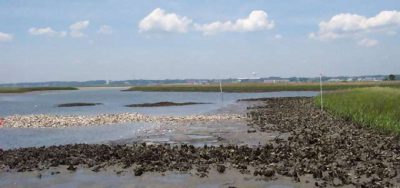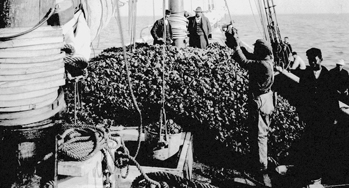OCEAN — The National Oceanic and Atmospheric Administration has given preliminary approval to a $1.3 million grant to the N.C. Coastal Federation for oyster restoration in Pamlico Sound, boosting the organization’s multi-decade efforts to turn the state into what founder and executive director Todd Miller believes can be “the Napa Valley” of oysters.
The money is part of $9 million for 17 habitat-restoration projects in coastal states. NOAA recommended all of the projects last month. Final approval depends on a legal review and on NOAA’s budget for the new fiscal year, which begins Oct. 1. The federation could receive as much as $4.3 million over a three-year period.
Supporter Spotlight
Miller said he believes that will happen, because even though federal budget appropriations have been uncertain in recent years, this program has been consistently well-funded. Either way, he said, it’s one of the most significant grants his organization has received, both in amount, but especially in potential effects on the state’s economy and a crucial part of its marine the environment.

In large part, that’s because the money leverages existing state appropriations to increase the acres of reef restored in North Carolina’s sounds. This year the state legislature appropriated $1.3 million for oyster restoration efforts in the state. The federal grant doubles the total funds available for oyster restoration in the next year.
As a result, Miller said, the federation and the state will embark on a joint effort that will be “industrial in scale” and will undoubtedly create jobs, both now, during construction, and in the future, as the oysters attracted to the reefs are harvested and sold.
“It’s truly a win-win-win,” Miller said. “What we’ll be doing is building environmental infrastructure. It’s like building highways and bridges and other infrastructure on land. There will be jobs for people who mine the rocks, for truck drivers, and for those who actually build the reefs. And down the road, there will be economic impacts for commercial fishermen, recreational fishermen and restaurants and other businesses.”
Oyster reefs are designated as essential fish habitat for at least 26 species of crabs, shrimp and fish that are important to North Carolina’s commercial and recreational fishing industries. It is estimated that every acre of reef annually produces $1,600 in commercial landings of finfish and crustaceans.
Supporter Spotlight
The federation is working with the state Division of Marine Fisheries to determine exactly where in Pamlico Sound the reefs will be built, Miller explained. They will be in water that’s 12 to 20 feet deep, so as not to pose any threats to navigation. The Army Corps of Engineers will be responsible for permitting.
“I think the most gratifying thing about this grant is that we will be working with the state, effectively doubling the work they can do,” he said. “It’s a great example of a public-private partnership.”
Through the NOAA project, at least 15 acres of oyster reef are to be created each year, with a total of 45 acres by the end of the three-year period. Miller said the state has a plan to create up to 500 acres of oyster reef, and this will significantly bolster the meeting of that total.

“We in North Carolina are in a great position to become the leader in oyster production,” he said. “Our waters have not gotten to the point that they did in the Chesapeake Bay, where they not only had to rebuild reefs, but also seed them. We are fortunate in that, if we build the reefs, the oysters will naturally reproduce.”
Beyond oyster production, of course, oysters have incredible value to the marine environment. An adult oyster can filter up to 1.3 gallons of water an hour as they feed. Scientists estimate that when oysters were at peak population in the Chesapeake, they could filter the volume of the whole bay in less than one week.
And, Miller said, a healthy oyster population is viewed as the proverbial “canary in the coal mine.” If the oyster population is healthy, so, almost surely, is the ecosystem.
Steve Murphey, chief of the Habitat and Enhancement Section for the N.C. Division of Marine Fisheries, agreed with Miller’s assessment of the grant, the project and the potential impact.
“We’re excited,” he said. “We did receive a good deal of money from the legislature this year for oyster reef rehabilitation and for sanctuary work, and this will enable us to double what we could have done otherwise. It is a really good example of what a public-private partnership can do to maximize use of funds. A lot of work has gone into this program and into getting the grant, and we are very appreciative.”
The reefs, Murphey said, will be high enough to be above low oxygen-level water, but low enough not to cause problems for boats. And, like Miller said, there’s no doubt that once constructed, the reefs will attract oyster larvae, and will become not only productive harvest areas for oystermen, but also for commercial and recreational fishermen seeking other species.

The NOAA grant is merely the latest step in a long effort by the federation to enhance the state’s oyster population. The organization has planted, with volunteers and staff, countless oyster shells and other materials to attract larvae, many of them in “living shorelines” that limit erosion along public and private land that borders estuaries. It has also held oyster summits that bring experts together to talk and exchange information about the best methods to increase the stock.
The organization also took the lead in developing a five-year plan for oyster stock rehabilitation between 2015 and 2020.
The idea, Miller said, is that through efforts on both fronts, the state should eventually be able to overtake Virginia as the nation’s top producer. “There’s no reason that can’t happen,” he said.
Oyster landings in North Carolina peaked in 1902, at 1.8 million bushels. But by 1994, plagued by development and pollution-laden stormwater runoff, habitat loss and Dermo, a parasitic disease that kills the shellfish before they reach the legal harvest limit, the state’s watermen harvested less than 35,000 bushels, worth a meager $632,000, according to state Division of Marine Fisheries figures. Landings didn’t crack 100,000 bushels again until 2009, and the recent peak was 198,674 bushels in 2010. It’s been uneven since, but consistently above 100,000 bushels; the 2015 total was 119,298 bushels, worth $3.9 million.







